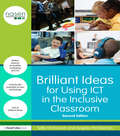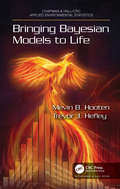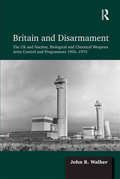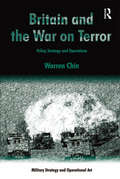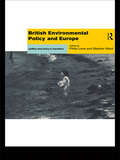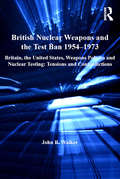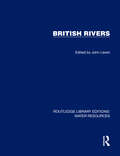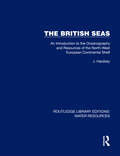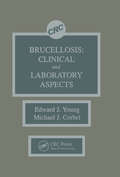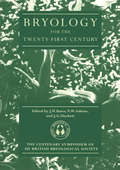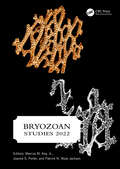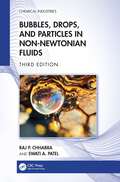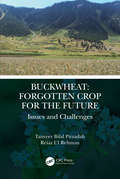- Table View
- List View
Brilliant Ideas for Using ICT in the Inclusive Classroom (David Fulton / Nasen Ser.)
by Sally McKeown Angela McGlashonRunner up in Teach Secondary’s Technology and Innovation Awards 2014 sponsored by Lego, Brilliant Ideas for using ICT in the Inclusive Classroom provides lots of simple practical ideas showing teachers and support staff how they can use ICT to boost the achievement of all pupils. How can you use ICT to boost the achievement of all your pupils? This practical teachers’ guide will help you to unlock the enormous potential of new technology in order to enhance pupils’ learning, particularly for young people with additional needs. Written by two of the UK’s leading technology experts, this invaluable and newly updated resource will enable you to use ICT effectively to make lessons more accessible, motivating and fun. With fifty illustrated case studies and twenty starter activities, this practical resource will help you to introduce new technology into the inclusive classroom. It has been specifically designed to help develop your pupils’ key skills, such as problem solving, developing concepts and communicating to different audiences. In each activity, the authors show why and how a particular resource was used and show how similar techniques can be implemented to open up the curriculum to your learners. The authors include timely and realistic advice on how to use a range of technologies from the cheap and cheerful – and even free – to more sophisticated and specialist packages. Find out about: Apps Blogging Digital animation Podcasting Digital storytelling Wikis Geocaching Coding Games and gaming Sat nav Art packages Twitter Whether you’re already techno-savvy or looking to get started with ICT, this book is full of brilliant ideas on how to engage learners of all abilities using technology. If you’re looking for inspiration on how to integrate creative uses of ICT with the curriculum, this book will prove invaluable.
Bringing Bayesian Models to Life (Chapman & Hall/CRC Applied Environmental Statistics)
by Mevin B. Hooten Trevor J. HefleyBringing Bayesian Models to Life empowers the reader to extend, enhance, and implement statistical models for ecological and environmental data analysis. We open the black box and show the reader how to connect modern statistical models to computer algorithms. These algorithms allow the user to fit models that answer their scientific questions without needing to rely on automated Bayesian software. We show how to handcraft statistical models that are useful in ecological and environmental science including: linear and generalized linear models, spatial and time series models, occupancy and capture-recapture models, animal movement models, spatio-temporal models, and integrated population-models. Features: R code implementing algorithms to fit Bayesian models using real and simulated data examples. A comprehensive review of statistical models commonly used in ecological and environmental science. Overview of Bayesian computational methods such as importance sampling, MCMC, and HMC. Derivations of the necessary components to construct statistical algorithms from scratch. Bringing Bayesian Models to Life contains a comprehensive treatment of models and associated algorithms for fitting the models to data. We provide detailed and annotated R code in each chapter and apply it to fit each model we present to either real or simulated data for instructional purposes. Our code shows how to create every result and figure in the book so that readers can use and modify it for their own analyses. We provide all code and data in an organized set of directories available at the authors' websites.
Bringing Bayesian Models to Life (Chapman & Hall/CRC Applied Environmental Statistics)
by Mevin B. Hooten Trevor J. HefleyBringing Bayesian Models to Life empowers the reader to extend, enhance, and implement statistical models for ecological and environmental data analysis. We open the black box and show the reader how to connect modern statistical models to computer algorithms. These algorithms allow the user to fit models that answer their scientific questions without needing to rely on automated Bayesian software. We show how to handcraft statistical models that are useful in ecological and environmental science including: linear and generalized linear models, spatial and time series models, occupancy and capture-recapture models, animal movement models, spatio-temporal models, and integrated population-models. Features: R code implementing algorithms to fit Bayesian models using real and simulated data examples. A comprehensive review of statistical models commonly used in ecological and environmental science. Overview of Bayesian computational methods such as importance sampling, MCMC, and HMC. Derivations of the necessary components to construct statistical algorithms from scratch. Bringing Bayesian Models to Life contains a comprehensive treatment of models and associated algorithms for fitting the models to data. We provide detailed and annotated R code in each chapter and apply it to fit each model we present to either real or simulated data for instructional purposes. Our code shows how to create every result and figure in the book so that readers can use and modify it for their own analyses. We provide all code and data in an organized set of directories available at the authors' websites.
Britain and Disarmament: The UK and Nuclear, Biological and Chemical Weapons Arms Control and Programmes 1956-1975
by John R. WalkerSince the use of poison gas during the First World War and the dropping of atomic bombs on Japan at the end of the Second World War, nuclear, biological or chemical (NBC) weapons have registered high on the fears of governments and individuals alike. Recognising both the particular horror of these weapons, and their potential for inflicting mass death and destruction, much effort has been expended in finding ways to eliminate such weapons on a multi-lateral level. Based on extensive official archives, this book looks at how successive British governments approached the subject of control and disarmament between 1956 and 1975. This period reflects the UK's landmark decision in 1956 to abandon its offensive chemical weapons programme (a decision that was reversed in 1963, but never fully implemented), and ends with the internal travails over the possible use of CR (tear gas) in Northern Ireland. Whilst the issue of nuclear arms control has been much debated, the integration of biological and chemical weapons into the wider disarmament picture is much less well understood, there being no clear statement by the UK authorities for much of the period under review in this book as to whether the country even possessed such weapons or had an active research and development programme. Through a thorough exploration of government records the book addresses fundamental questions relating to the history of NBC weapons programmes, including the military, economic and political pressures that influenced policy; the degree to which the UK was a reluctant or enthusiastic player on the international arms control stage; and the effect of international agreements on Britain's weapons programmes. In exploring these issues, the study provides the first attempt to assess UK NBC arms control policy and practice during the Cold War.
Britain and Disarmament: The UK and Nuclear, Biological and Chemical Weapons Arms Control and Programmes 1956-1975
by John R. WalkerSince the use of poison gas during the First World War and the dropping of atomic bombs on Japan at the end of the Second World War, nuclear, biological or chemical (NBC) weapons have registered high on the fears of governments and individuals alike. Recognising both the particular horror of these weapons, and their potential for inflicting mass death and destruction, much effort has been expended in finding ways to eliminate such weapons on a multi-lateral level. Based on extensive official archives, this book looks at how successive British governments approached the subject of control and disarmament between 1956 and 1975. This period reflects the UK's landmark decision in 1956 to abandon its offensive chemical weapons programme (a decision that was reversed in 1963, but never fully implemented), and ends with the internal travails over the possible use of CR (tear gas) in Northern Ireland. Whilst the issue of nuclear arms control has been much debated, the integration of biological and chemical weapons into the wider disarmament picture is much less well understood, there being no clear statement by the UK authorities for much of the period under review in this book as to whether the country even possessed such weapons or had an active research and development programme. Through a thorough exploration of government records the book addresses fundamental questions relating to the history of NBC weapons programmes, including the military, economic and political pressures that influenced policy; the degree to which the UK was a reluctant or enthusiastic player on the international arms control stage; and the effect of international agreements on Britain's weapons programmes. In exploring these issues, the study provides the first attempt to assess UK NBC arms control policy and practice during the Cold War.
Britain and the War on Terror: Policy, Strategy and Operations (Military Strategy and Operational Art)
by Warren ChinWhy did Britain come to play such a prominent role in the war on terror and why did the military instrument come to be the dominant theme in the British prosecution of what was an ideological and political struggle? This book is an analysis of Britain’s war against Al Qaeda and the phenomenon of international terrorism which marked a paradigm shift in the nature and conduct of war in the twenty-first century. At the heart of the book is an attempt to understand why Britain, which possessed a wealth of experience in the conduct of counterterrorism, counterinsurgency and small wars, developed a strategic and operational design to defeat the Islamist threat which proved to be deeply flawed. In addressing this question the book explores the complex intellectual, doctrinal and geopolitical challenge posed by Al Qaeda and international terrorism and how and why the British response took the form that it did. In conducting this analysis the book raises important questions about the assumptions and perceptions of those in government who led the UK into this conflict, the nature of the civil military relationship in Britain and how well it functioned, and finally the competence of its security forces in being able to deal with this threat both domestically and overseas.
Britain and the War on Terror: Policy, Strategy and Operations (Military Strategy and Operational Art)
by Warren ChinWhy did Britain come to play such a prominent role in the war on terror and why did the military instrument come to be the dominant theme in the British prosecution of what was an ideological and political struggle? This book is an analysis of Britain’s war against Al Qaeda and the phenomenon of international terrorism which marked a paradigm shift in the nature and conduct of war in the twenty-first century. At the heart of the book is an attempt to understand why Britain, which possessed a wealth of experience in the conduct of counterterrorism, counterinsurgency and small wars, developed a strategic and operational design to defeat the Islamist threat which proved to be deeply flawed. In addressing this question the book explores the complex intellectual, doctrinal and geopolitical challenge posed by Al Qaeda and international terrorism and how and why the British response took the form that it did. In conducting this analysis the book raises important questions about the assumptions and perceptions of those in government who led the UK into this conflict, the nature of the civil military relationship in Britain and how well it functioned, and finally the competence of its security forces in being able to deal with this threat both domestically and overseas.
British Environmental Policy and Europe: Politics and Policy in Transition
by Stephen Ward Philip LoweThis book explores the effectiveness of the response of environmental groups and organisations in Britain in to the challenges of European integration. Examining the relative European orientation of British environmental policy, and the impact of British concerns on European environmental policy, the book examines issues of environmental diplomacy, institutional dynamics, and policy debates relating to specific concerns such as: * pollution * land use * transport * natural conservation Presenting a wealth of examples throughout, the book draws together contributions from leading academics and practitioners from institutions and organisations such as the DOE, European Commission, WWF and CPRE.
British Environmental Policy and Europe: Politics and Policy in Transition (Global Environmental Change Ser.)
by Philip Lowe Stephen WardThis book explores the effectiveness of the response of environmental groups and organisations in Britain in to the challenges of European integration. Examining the relative European orientation of British environmental policy, and the impact of British concerns on European environmental policy, the book examines issues of environmental diplomacy, institutional dynamics, and policy debates relating to specific concerns such as: * pollution * land use * transport * natural conservation Presenting a wealth of examples throughout, the book draws together contributions from leading academics and practitioners from institutions and organisations such as the DOE, European Commission, WWF and CPRE.
British Nuclear Weapons and the Test Ban 1954-1973: Britain, the United States, Weapons Policies and Nuclear Testing: Tensions and Contradictions
by John R. WalkerIn 1962 Dean Acheson famously described Britain as having lost an Empire but not yet found a role. Perhaps nowhere is this more apparent than in the realms of nuclear weapons. An increasingly marginal world power, successive post-war British governments felt that an independent nuclear deterrent was essential if the country was to remain at the top table of world diplomacy. Focusing on a key twenty-year period, this study explores Britain's role in efforts to bring about a nuclear test ban treaty between 1954 and 1973. Taking a broadly chronological approach, it examines the nature of defence planning, the scientific goals that nuclear tests were designed to secure, Anglo-American relationships, the efficacy of British diplomacy and its contribution to arms control and disarmament. A key theme of the study is to show how the UK managed to balance the conflicting pressures created by its determination to remain a credible nuclear power whilst wanting to pursue disarmament objectives, and how these pressures shifted over the period in question. Based on a wealth of primary sources this book opens up the largely ignored subject of the impact of arms control on the UK nuclear weapons programme. Its appraisal of the relationship between the requirements and developments of the UK nuclear weapons programme against international and domestic pressures for a test ban treaty will be of interest to anyone studying post-war British defence and foreign policy, history of science, arms control, disarmament and non-proliferation and international relations. It also provides important background information on current events involving nuclear proliferation and disarmament.
British Nuclear Weapons and the Test Ban 1954-1973: Britain, the United States, Weapons Policies and Nuclear Testing: Tensions and Contradictions
by John R. WalkerIn 1962 Dean Acheson famously described Britain as having lost an Empire but not yet found a role. Perhaps nowhere is this more apparent than in the realms of nuclear weapons. An increasingly marginal world power, successive post-war British governments felt that an independent nuclear deterrent was essential if the country was to remain at the top table of world diplomacy. Focusing on a key twenty-year period, this study explores Britain's role in efforts to bring about a nuclear test ban treaty between 1954 and 1973. Taking a broadly chronological approach, it examines the nature of defence planning, the scientific goals that nuclear tests were designed to secure, Anglo-American relationships, the efficacy of British diplomacy and its contribution to arms control and disarmament. A key theme of the study is to show how the UK managed to balance the conflicting pressures created by its determination to remain a credible nuclear power whilst wanting to pursue disarmament objectives, and how these pressures shifted over the period in question. Based on a wealth of primary sources this book opens up the largely ignored subject of the impact of arms control on the UK nuclear weapons programme. Its appraisal of the relationship between the requirements and developments of the UK nuclear weapons programme against international and domestic pressures for a test ban treaty will be of interest to anyone studying post-war British defence and foreign policy, history of science, arms control, disarmament and non-proliferation and international relations. It also provides important background information on current events involving nuclear proliferation and disarmament.
British Rivers (Routledge Library Editions: Water Resources)
Originally published in 1981, this book describes and interprets the physical nature of British rivers and is authored by leading authors from universities, the Institute of Hydrology and a water Authority. The contents include data on river regimes and catchment characteristics, information on water quality in both polluted and unpolluted rivers, a full discussion of river channels and their erosion and sediment characteristics, and a consideration of river management problems in the distinctive British context. Where possible, nationwide information is presented in map form and many of the maps presented a national picture for the first time. The book will be of interest to students and scientists in a wide range of disciplines: geography, geology, environmental science, hydrology and engineering. Those professionally engaged in environmental management and the water industry should also find it useful. In summary, all who are concerned with rivers – as agents of landscape change, sedimenting phenomena, environmental resources or flood hazards will find this book as relevant now as when it was first published.
British Rivers (Routledge Library Editions: Water Resources)
by John LewinOriginally published in 1981, this book describes and interprets the physical nature of British rivers and is authored by leading authors from universities, the Institute of Hydrology and a water Authority. The contents include data on river regimes and catchment characteristics, information on water quality in both polluted and unpolluted rivers, a full discussion of river channels and their erosion and sediment characteristics, and a consideration of river management problems in the distinctive British context. Where possible, nationwide information is presented in map form and many of the maps presented a national picture for the first time. The book will be of interest to students and scientists in a wide range of disciplines: geography, geology, environmental science, hydrology and engineering. Those professionally engaged in environmental management and the water industry should also find it useful. In summary, all who are concerned with rivers – as agents of landscape change, sedimenting phenomena, environmental resources or flood hazards will find this book as relevant now as when it was first published.
The British Seas: An Introduction to the Oceanography and Resources of the North-West European Continental Shelf (Routledge Library Editions: Water Resources)
by Jack HardistyOriginally published in 1990 and designed as a student text, The British Seas is a clear introduction to the oceanography and resources of the region. It is unique in providing a detailed review of the resources of the north-west European continental shelf together with a comprehensive description of the environment. Introducing the shelf region as if it were a new country, Jack Hardisty explores first its physical environment and then summarizes the distribution and exploitation of resources from the environment. Part 1 – on the oceanography - covers the shape of the shelf, its geological history and its wave and tidal regimes. Part 2 – on the resources – looks at trade and shipping, and the hydrocarbon, fishing and seabed mining industries. It goes on to discuss wave and tidal power, and to consider the problem of pollution in terms of resource utilization. The industrial technology and the environmental potential of each resource are examined, and the economic and legislative restrictions are analysed.
The British Seas: An Introduction to the Oceanography and Resources of the North-West European Continental Shelf (Routledge Library Editions: Water Resources)
by Jack HardistyOriginally published in 1990 and designed as a student text, The British Seas is a clear introduction to the oceanography and resources of the region. It is unique in providing a detailed review of the resources of the north-west European continental shelf together with a comprehensive description of the environment. Introducing the shelf region as if it were a new country, Jack Hardisty explores first its physical environment and then summarizes the distribution and exploitation of resources from the environment. Part 1 – on the oceanography - covers the shape of the shelf, its geological history and its wave and tidal regimes. Part 2 – on the resources – looks at trade and shipping, and the hydrocarbon, fishing and seabed mining industries. It goes on to discuss wave and tidal power, and to consider the problem of pollution in terms of resource utilization. The industrial technology and the environmental potential of each resource are examined, and the economic and legislative restrictions are analysed.
Brucellosis: Clinical and Laboratory Aspects
by Edward J. Young Michael J. CorbelFourteen brucellosis experts from seven countries discuss the history, epidemiology, microbiology, immunology, diagnosis, treatment, and control of brucellosis in animals and man. Edited by members of the World Health Organization's Expert Committee on Brucellosis, this text is the first comprehensive treatment of the disease since The Nature of Brucellosis by Wesley W. Spink in 1956. Topics reviewed with current references include infection caused by newer species of Brucella, such as B. canis, newer diagnostic techniques, such as radioimmunoassay and ELISA, and newer treatments, such as rifampin and the quinolones. The pathogenesis and pathophysiology of brucellosis is reviewed in depth, correlating the disease in animals with the illness in humans. This volume is extremely useful for clinicians, researchers, and students in medicine, veterinary science, microbiology, immunology, epidemiology, public health, and international health.
Brucellosis: Clinical and Laboratory Aspects
by Edward J. Young Michael J. CorbelFourteen brucellosis experts from seven countries discuss the history, epidemiology, microbiology, immunology, diagnosis, treatment, and control of brucellosis in animals and man. Edited by members of the World Health Organization's Expert Committee on Brucellosis, this text is the first comprehensive treatment of the disease since The Nature of Brucellosis by Wesley W. Spink in 1956. Topics reviewed with current references include infection caused by newer species of Brucella, such as B. canis, newer diagnostic techniques, such as radioimmunoassay and ELISA, and newer treatments, such as rifampin and the quinolones. The pathogenesis and pathophysiology of brucellosis is reviewed in depth, correlating the disease in animals with the illness in humans. This volume is extremely useful for clinicians, researchers, and students in medicine, veterinary science, microbiology, immunology, epidemiology, public health, and international health.
Bryology for the Twenty-first Century
by Jeffrey W. BatesA compilation of state of the art papers on key topics in bryology from invited speakers at the Centenary Symposium, University of Glasgow, 57 August 1996.
Bryology for the Twenty-first Century
by Jeffrey W. BatesA compilation of state of the art papers on key topics in bryology from invited speakers at the Centenary Symposium, University of Glasgow, 57 August 1996.
Bryozoan Studies 2022: PROCEEDINGS OF THE NINETEENTH INTERNATIONAL BRYOZOOLOGY ASSOCIATION CONFERENCE (DUBLIN, IRELAND, 22-26 AUGUST 2022)
by Marcus M. Key Joanne S. Porter Wyse Jackson, Patrick N.Bryozoan Studies 2022 contains nineteen papers presented at the 19th International Conference of the International Bryozoology Association held at Trinity College Dublin in August 2022. Bryozoans are complex and fascinating colonial organisms that range from Cambrian to the present day and which are found in marine and freshwater environments from pole to pole and subtidal to abyssal. Recent tomographic techniques have revolutionised the study of modern and fossil taxa where internal structures are revealed through non-destructive methodologies. Here the internal structure of some Ordovician and Eocene taxa is illustrated through these methods. Phylogenetic studies of bryozoans question the classic classification of the group; here the phylogeny of species from California and Japan is described. Other topics covered are assessments of Recent faunas from Haiti and fossil assemblages from Mexico and the United States. Distributional patterns from the Arctic and New Zealand and the dispersal patterns of bryozoans on rafted pumice and on slipper lobsters are characterised. Further contributions provide descriptions of a rare Permian taxon, clarification of species assigned to the Upper Palaeozoic genus Stenopora, avicularia in Wilbertopora, enigmatic structures in a fenestrate bryozoan, repair structures in trepostomes, and an assessment of skeletonisation in the families of Palaeozoic orders.
Bryozoan Studies 2022: PROCEEDINGS OF THE NINETEENTH INTERNATIONAL BRYOZOOLOGY ASSOCIATION CONFERENCE (DUBLIN, IRELAND, 22-26 AUGUST 2022)
by Marcus M. Key Joanne S. Porter Patrick N. Wyse JacksonBryozoan Studies 2022 contains nineteen papers presented at the 19th International Conference of the International Bryozoology Association held at Trinity College Dublin in August 2022. Bryozoans are complex and fascinating colonial organisms that range from Cambrian to the present day and which are found in marine and freshwater environments from pole to pole and subtidal to abyssal. Recent tomographic techniques have revolutionised the study of modern and fossil taxa where internal structures are revealed through non-destructive methodologies. Here the internal structure of some Ordovician and Eocene taxa is illustrated through these methods. Phylogenetic studies of bryozoans question the classic classification of the group; here the phylogeny of species from California and Japan is described. Other topics covered are assessments of Recent faunas from Haiti and fossil assemblages from Mexico and the United States. Distributional patterns from the Arctic and New Zealand and the dispersal patterns of bryozoans on rafted pumice and on slipper lobsters are characterised. Further contributions provide descriptions of a rare Permian taxon, clarification of species assigned to the Upper Palaeozoic genus Stenopora, avicularia in Wilbertopora, enigmatic structures in a fenestrate bryozoan, repair structures in trepostomes, and an assessment of skeletonisation in the families of Palaeozoic orders.
Bubbles, Drops, and Particles in Non-Newtonian Fluids (Chemical Industries)
by Raj P. Chhabra Swati A. PatelThe third edition of Bubbles, Drops, and Particles in Non-Newtonian Fluids provides comprehensive coverage of the scientific foundations and the latest advances in particle motion in non-Newtonian media. Thoroughly updating and expanding its best-selling predecessor, this edition addresses numerical and experimental developments in non-Newtonian particulate systems. It includes a new chapter on heat transfer in non-Newtonian fluids in the free and mixed convection regimes and thus covers forced convection regimes separately in this edition. Salient Features: Demonstrates how dynamic behavior of single particles can yield useful information for modeling transport processes in complex multiphase flows. Addresses heat transfer in Generalized Newtonian Fluid (GNF), visco-plastic and visco-elastic fluids throughout the book and outlines potential strategies for heat transfer enhancement. Provides a new detailed section on the effect of confinement on heat transfer from bluff-bodies in non-Newtonian fluids. Written in a clear and concise manner, this book remains an excellent handbook and reference. It is essential reading for students and researchers interested in exploring particle motion in different types of non-Newtonian systems encountered in disciplines across engineering and the sciences.
Bubbles, Drops, and Particles in Non-Newtonian Fluids (Chemical Industries)
by Raj P. Chhabra Swati A. PatelThe third edition of Bubbles, Drops, and Particles in Non-Newtonian Fluids provides comprehensive coverage of the scientific foundations and the latest advances in particle motion in non-Newtonian media. Thoroughly updating and expanding its best-selling predecessor, this edition addresses numerical and experimental developments in non-Newtonian particulate systems. It includes a new chapter on heat transfer in non-Newtonian fluids in the free and mixed convection regimes and thus covers forced convection regimes separately in this edition. Salient Features: Demonstrates how dynamic behavior of single particles can yield useful information for modeling transport processes in complex multiphase flows. Addresses heat transfer in Generalized Newtonian Fluid (GNF), visco-plastic and visco-elastic fluids throughout the book and outlines potential strategies for heat transfer enhancement. Provides a new detailed section on the effect of confinement on heat transfer from bluff-bodies in non-Newtonian fluids. Written in a clear and concise manner, this book remains an excellent handbook and reference. It is essential reading for students and researchers interested in exploring particle motion in different types of non-Newtonian systems encountered in disciplines across engineering and the sciences.
Buckwheat: Issues and Challenges
by Tanveer Bilal Pirzadah Reiaz Ul RehmanBuckwheat: Forgotten crop for the Future offers an overview of this globally important crop, including its history, origin and its importance to functional food sector. Due to its short growth span, ability to grow at higher altitudes and superior quality of its protein, buckwheat is considered as an important crop for addressing global food requirements. The book also provides upto date information on the abiotic stress tolerance properties of the crop including its hyperaccumulating potential. The book talks about the issues and challenges being faced for adopting this crop and the ways to address and overcome these limitations. The book guides the readers through different varietal adaptations and provides information on appropriate research directions. This book would serve as an ideal guide for researchers and advanced-level students seeking better understanding of the buckwheat crop. Introduces the buckwheat’s origin, history and diversity Summarizes the distribution of buckwheat species around the world Presents agro-techniques and cultivation practices of buckwheat Explores the nutraceutical potential of buckwheat Includes adaptation of buckwheat towards different environmental factors affecting growth and production Discusses the reasons for declining buckwheat production Addresses the strategies for buckwheat crop improvement
Buckwheat: Issues and Challenges
by Tanveer Bilal Pirzadah Reiaz Ul RehmanBuckwheat: Forgotten crop for the Future offers an overview of this globally important crop, including its history, origin and its importance to functional food sector. Due to its short growth span, ability to grow at higher altitudes and superior quality of its protein, buckwheat is considered as an important crop for addressing global food requirements. The book also provides upto date information on the abiotic stress tolerance properties of the crop including its hyperaccumulating potential. The book talks about the issues and challenges being faced for adopting this crop and the ways to address and overcome these limitations. The book guides the readers through different varietal adaptations and provides information on appropriate research directions. This book would serve as an ideal guide for researchers and advanced-level students seeking better understanding of the buckwheat crop. Introduces the buckwheat’s origin, history and diversity Summarizes the distribution of buckwheat species around the world Presents agro-techniques and cultivation practices of buckwheat Explores the nutraceutical potential of buckwheat Includes adaptation of buckwheat towards different environmental factors affecting growth and production Discusses the reasons for declining buckwheat production Addresses the strategies for buckwheat crop improvement
